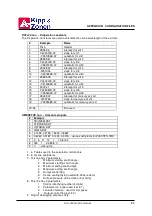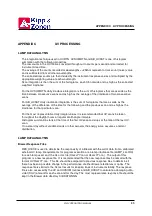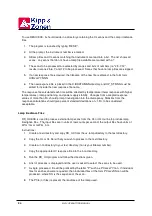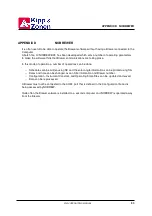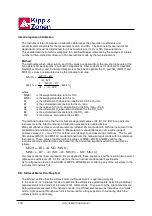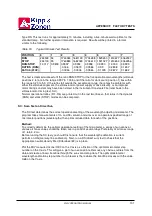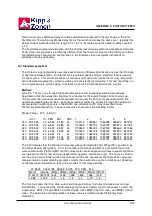
MKIV OPERATOR'S MANUAL
96
Following each block of measurements the deadtime mean and deadtime standard deviation (in
nanoseconds) are calculated and printed. The high- and low-intensity deadtime means should
agree (within an acceptance tolerance of two standard deviations), and should lie in the range 35 to
50 nanoseconds. Failure to meet this criterion indicates possible difficulties with either the slitmask
motor operation, the high-voltage circuitry, or photon counting circuitry.
This newly determined deadtime constant should not be entered into the instrument Constants File
unless it is significantly different (by more than about 5 ns) from the old value (if you are confident
that the instrument is currently running properly). You should contact the factory before altering the
stored constant since a complete recalibration may be required.
HG: Mercury-Line Wavelength Calibration
The HG test precisely locates the mercury line-spectrum, then repositions the micrometer so that
the diffraction grating disperses the five operating wavelengths onto the appropriate exit slits. The
test uses the mercury discharge lamp and the Hg calibration slit (slitmask position 0).
The software establishes the position of the mercury line-spectrum by scanning the micrometer
forwards from step position 50 to step 240 in 10-step increments, then reversing direction and
scanning from step 240 back to step 50 (note: 1 micrometer step 0.007 nm). At each position the
light intensity dispersed through the calibration slit is recorded, building a 20-point profile of the
mercury spectrum. This measured spectrum is compared with an internally-stored reference
spectrum to determine that step position which maximizes the correlation between the measured
and stored spectra. If this interpolated step number falls within the acceptance limits
[147.00..149.99] the mercury spectrum is deemed to have been located, and the micrometer is
moved to its operational setting (step number 286 ± 3, or 13 ± 3 micrometer steps below the
mercury calibration point; this small displacement is an instrument-dependent constant known as
the 'offset' stored in the instrument Constants File, and is determined by the SC test). If, however,
the mercury calibration point falls outside the acceptance range, the micrometer is reset to the
newly calibrated step number and the test repeated. Iterations continue until the calibration point
converges correctly.
Method:
The command HG is issued.
The program will read and display the current Brewer temperature, and a checklist of
required foreoptic settings will then be displayed:
** measurement procedure ***
check:
1 - filter #1 to position #1
2 - filter #2 to position #0
3 - open iris
4 - rotate director prism to lamps
* press return when ready *
These controllable elements will be set automatically.
After a five-minute lamp warm-up period the program will perform a series of intensity
measurements over a micrometer step-number range of 50 to 280 as described earlier. The photon
count for each observation point is displayed on the screen. You should observe a peaking trend as
the micrometer passes through step position 150 (sample number 15). When the micrometer has
completed its there-and-back journey the program computes and displays the five correlation
coefficients corresponding to attempted curve matchings (between the measured spectrum and the
internally-stored reference spectrum) at step positions 110, 130, 150, 170, 190. From these
measurements the mercury calibration point is determined and printed in the following format:
Brewer Temp = 29 C (3.66 V)
190112 ( .987) HG CALD AT STEP# 298.47 SET TO STEP# 286 9540
Summary of Contents for BREWER MK IV
Page 1: ...INSTRUCTION MANUAL OM BA C230 B Mk IV...
Page 2: ...REVISION HISTORY REV DESCRIPTION DCN DATE APPD B Update 99 16 12 C Update 07 16 10...
Page 3: ...ii...
Page 5: ...2...
Page 7: ...4...
Page 25: ...MKIV OPERATOR S MANUAL 22...
Page 57: ...MKIV OPERATOR S MANUAL 54...
Page 61: ...MKIV OPERATOR S MANUAL 58...
Page 81: ...MKIV OPERATOR S MANUAL 78...
Page 91: ...MKIV OPERATOR S MANUAL 88...
Page 93: ...MKIV OPERATOR S MANUAL 90...
Page 127: ...MKIV OPERATOR S MANUAL 124...
Page 133: ...MKIV OPERATOR S MANUAL 130...
Page 135: ...MKIV OPERATOR S MANUAL 132...


